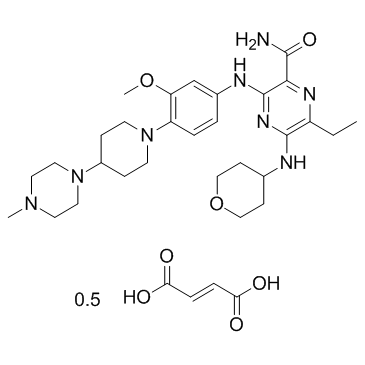1254053-84-3
| Name | Gilteritinib hemifumarate |
|---|---|
| Synonyms |
ASP2215 hemifumarate
2-Pyrazinecarboxamide, 6-ethyl-3-[[3-methoxy-4-[4-(4-methyl-1-piperazinyl)-1-piperidinyl]phenyl]amino]-5-[(tetrahydro-2H-pyran-4-yl)amino]-, (2E)-2-butenedioate (2:1) 5RZZ0Z1GJT 6-ethyl-3-{3-methoxy-4-[4-(4-methylpiperazin-1-yl)piperidin-1-yl]anilino}-5-(oxan-4-ylamino)pyrazine-2-carboxamide hemi-(2E)-but-2-enedioate Gilteritinib fumarate 6-Ethyl-3-({3-methoxy-4-[4-(4-methyl-1-piperazinyl)-1-piperidinyl]phenyl}amino)-5-(tetrahydro-2H-pyran-4-ylamino)-2-pyrazinecarboxamide (2E)-2-butenedioate (2:1) |
| Description | Gilteritinib hemifumarate is a potent FLT3/AXL inhibitor with IC50 of 0.29 nM/0.73 nM, respectively. |
|---|---|
| Related Catalog | |
| Target |
IC50: 0.29 nM (FLT3)[1] IC50: 0.35 nM (LTK), 0.73 nM (AXL), 1.2 nM (EML4-ALK), 230 nM (c-KIT)[2] |
| In Vitro | Of the 78 tyrosine kinases tested, Gilteritinib (ASP2215) inhibits FLT3, leukocyte tyrosine kinase (LTK), anaplastic lymphoma kinase (ALK), and AXL kinases by over 50% at 1 nM with an IC50 value of 0.29 nM for FLT3, approximately 800-fold more potent than for c-KIT[1]. Gilteritinib inhibits the activity of eight of the 78 tested kinases by over 50% at concentrations of either 1 nM (FLT3, LTK, ALK, and AXL) or 5 nM (TRKA, ROS, RET, and MER). The IC50s are 0.29 nM for FLT3 and 0.73 nM for AXL. Gilteritinib inhibits FLT3 at an IC50 that is approximately 800-fold more potent than the concentration required to inhibit c-KIT (230 nM). The antiproliferative activity of Gilteritinib is evaluated against MV4-11 and MOLM-13 cells, which endogenously express FLT3-ITD. After 5 days of treatment, Gilteritinib inhibits the growth of MV4-11 and MOLM-13 cells with mean IC50s of 0.92 nM (95% CI: 0.23-3.6 nM) and 2.9 nM (95% CI: 1.4-5.8 nM), respectively. Growth suppression of MV4-11 cells is accompanied by inhibition of FLT3 phosphorylation. Relative to vehicle control cells, phosphorylated FLT3 levels are 57%, 8%, and 1% after 2 h of treatment with 0.1 nM, 1 nM, and 10 nM Gilteritinib, respectively. In addition, doses as low as 0.1 nM or 1 nM result in the suppression of phosphorylated ERK, STAT5, and AKT, all of which are downstream targets of FLT3 activation. To investigate the effects of Gilteritinib on AXL inhibition, MV4-11 cells that expressed exogenous AXL are treated with Gilteritinib. At concentrations of 1 nM, 10 nM, and 100 nM for 4 h, Gilteritinib treatment decreases phosphorylated AXL levels by 38%, 29%, and 22%, respectively[2]. |
| In Vivo | In MV4-11 xenografted-mice, the concentration of Gilteritinib (ASP2215) in tumors is more than 20-fold higher than that in plasma with oral administration of Gilteritinib at 10 mg/kg for 4 days. Treatment of Gilteritinib for 28 days results in dose-dependent inhibition of MV4-11 tumor growth and induces complete tumor regression at more than 6 mg/kg. Further, Gilteritinib decreases tumor burden in bone marrow and prolonged the survival of mice intravenously transplanted with MV4-11 cells[1]. |
| Kinase Assay | The kinase inhibitory activity of Gilteritinib is tested against a panel of 78 tested kinases using ATP concentrations that are approximately equal to the Km value for each kinase in a TK-ELISA or off-chip mobility shift assay. Initially, two concentrations of Gilteritinib (1 nM and 5 nM) are tested to assess each compound’s inhibitory effect on TK activity. Further studies are then conducted using a dose range of Gilteritinib to determine IC50 values for kinases in which activity is inhibited by >50% with 1 nM Gilteritinib as well as for c-KIT. TK-ELISA and MSA assays are used to conduct IC50 studies for FLT3, LTK, AXL, and c-KIT; the HTRF KinEASE-TK assay is performed to assess the IC50 value of echinoderm microtubule-associated protein-like 4-ALK (EML4-ALK)[2]. |
| Cell Assay | The effect of Gilteritinib on MV4-11 and MOLM-13 cells is assessed using the CellTiter-Glo Luminescent Cell Viability Assay. Subsequent studies are conducted to examine the effect of Gilteritinib and Quizartinib on Ba/F3 cells expressing either FLT3-ITD, FLT3-D835Y, FLT3-ITD-D835Y, FLT3-ITD-F691 L, or FLT3-ITD-F691I. MV4-11 and MOLM-13 cells are treated with DMSO or increasing concentrations of Gilteritinib (0.01, 0.1, 1, 10, and 100 nM) for 5 days, and cell viability is measured using CellTiter-Glo[2]. |
| Animal Admin | Mice[1] Antitumor activity is evaluated in nude mice transplanted with MV4-11 AML cells. The pharmacokinetics in xenografted mice is also investigated. MV4-11 xenografted-mice are treated with oral administration of Gilteritinib at 10 mg/kg for 4 days. Treatment of Gilteritinib for 28 days results in dose-dependent inhibition of MV4-11 tumor growth and induces complete tumor regression at more than 6 mg/kg[1]. |
| References |
| Molecular Formula | C29H44N8O30.5C4H4O4 |
|---|---|
| Molecular Weight | 610.75 |
| Storage condition | 2-8℃ |
